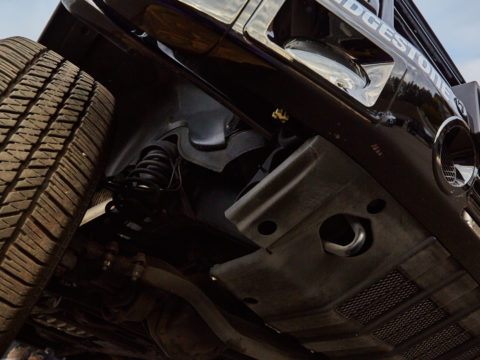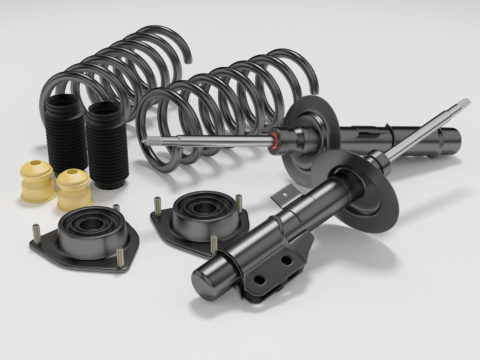Shocks and struts are the components in your car responsible for making your ride smooth. They absorb impact from the road surface and distribute your vehicle’s weight to both axles.
Struts are often found on front axles with shocks on rear axles but never on the same wheel. Regularly replacing them after prolonged use ensures your vehicle is safe to drive.

Below is an outline of all you need to know to guarantee you regularly maintain your shocks and struts.
Contents
What Is the Average Cost to Replace Shocks and Struts?
The average cost for strut replacement is between $450 to $900. On the other hand, shock replacement will cost you between $250 to $600.
The listed figures are inclusive of labor fees for your mechanic. The average cost for mechanics services is between $150 to $300. However, the total cost may vary.
For example, auto repair shops identifying as luxury brands may charge premium fees.
How Much Are Shocks and Struts?
Expect to spend $300 to $600 for struts and $100 to $300 for shocks. However, the purchase price may vary depending on several factors.
They include the brand of shocks and struts you buy and your vehicle’s brand and model.
Symptoms of Bad Shocks and Struts?
Shocks and struts wear out like all other parts of your vehicle. They are responsible for insulating your vehicle against forces endured while you drive.
They wear out at accelerated rates if you drive on rough, bumpy roads. Some signs your shocks and struts are wearing out include:
a. Trouble Braking
Bad shocks and struts can contribute to issues in braking. These issues can include reduced response time and vehicle nosediving whenever you brake. Moreover, such lagging can be dangerous in emergencies.
b. Uncomfortable Rides
Shocks and struts make vehicle rides comfortable by absorbing shocks from bumpy roads. You will likely feel most of the bumps and obstacles your vehicle passes over when they wear out.
Your rides will be especially uncomfortable when going off-road.
c. Covered Distance
Most vehicle manufacturers recommend the mileage you should travel before replacing your shocks and struts.
It is advisable to replace the shocks and struts once your vehicle covers the distance. Otherwise, you risk road accidents that can be fatal.
d. Fluid Leaks
Shocks and struts require hydraulic fluid to work smoothly. Any leaks around them might indicate they are bad and require replacement. Do not wait until your vehicle breaks down to refill the fluid.
e. Unstable Steering
Your shocks and struts may have issues should you notice your vehicle is not turning as smoothly as before. The difference will be especially noticeable when you turn or drive on highways at high speeds.
Schedule an inspection to identify and remedy the underlying issues.
Overall, if you are unsure of when you need to replace your shocks and struts, be on the lookout for the following signs.

Should You Replace Shocks and Struts at the Same Time?
Yes. It would be best if you replace your shocks and struts simultaneously. Since shocks and struts work to maintain your vehicle’s balance through even weight distribution, they tend to wear out at similar rates.
Therefore, whenever the right shock or strut is damaged, it is highly likely that the left one is also close to breaking down.
Moreover, dealers sell shocks and struts in pairs. Thus, manufacturers recommend replacing the shocks and struts at the same time.
However, there may be differences in how fast your front and rear axles wear out. As such, you can replace the front or rear axle shocks and struts first, depending on how much they are worn out.
Ideally, mechanics recommend replacing all four shocks and struts simultaneously for consistent and improved handling and control.
What Happens if You Don’t Replace Shocks and Struts?
Your vehicle’s suspension system is vital in ensuring it functions effectively. Failure to replace shocks and struts can adversely affect your vehicle’s performance.
Issues that may arise when you don’t replace your shocks and struts include:
- Damage to the suspension. Bad shocks and struts cause your vehicle to bounce a lot when driving. These constant movements and vibrations may affect joints and bearings in the suspension system.
- Uncomfortable rides. A bumpy ride on a smooth road is one of the signs of compromised shocks and struts. Failure to replace the damaged parts will make the rides increasingly uncomfortable.
- Poor handling and control. Shocks and struts distribute weight evenly across your vehicle’s chassis. They foster vehicle stability by guaranteeing balance and proper handling and control.
Overall, failing to replace shocks and struts reduces your steering control. The impairments may manifest as sways on the road, predisposing you to accidents.
How Long Can You Drive with Bad Shocks and Struts?
You should not drive your car for long if it has faulty shocks and struts. If possible, you should avoid driving it because bad shocks and struts can seriously compromise your vehicle’s safety.
However, if you are already on the road, you should consider calling a tow truck to ferry your car to a mechanic for repairs.
Be careful while driving the car to the mechanic if a tow truck is not an option. The bad shocks and struts might cause uneven wear and tear on your tires, affecting their ability to grip road surfaces.
In addition, steering and braking a vehicle with bad shocks and struts can be difficult. Thus you should avoid driving a car with bad shocks and struts to prevent the risk of causing an accident.
The risk is significantly high should you drive on a busy road or highway.
Cheapest Place to Get Shocks Installed
Local mechanic shops are the most affordable places to install your vehicle’s shocks. You may consider your mechanic since they are already aware of the workings of your vehicle and help you schedule maintenance.
Moreover, your working relationship may help you get discounts. It is important to note that replacements done at a car dealership will be higher than the earlier average cost.
Therefore, trust your local mechanic to provide affordable and fair pricing; if not, compare the pricing of competing mechanics to get the best deal.














